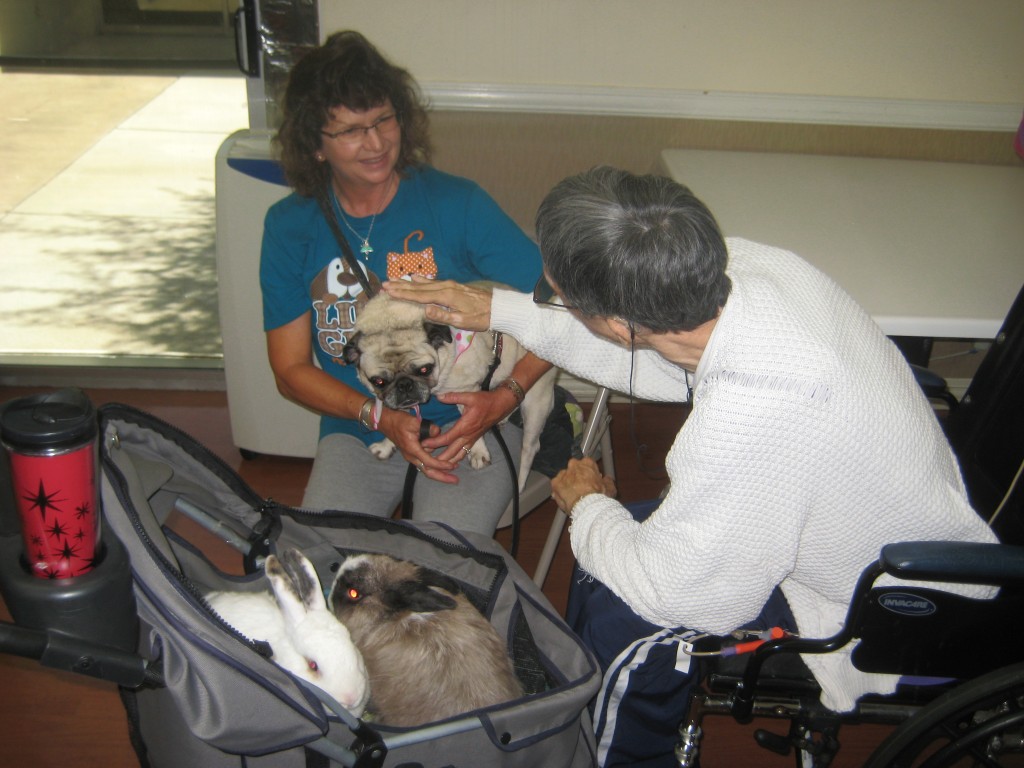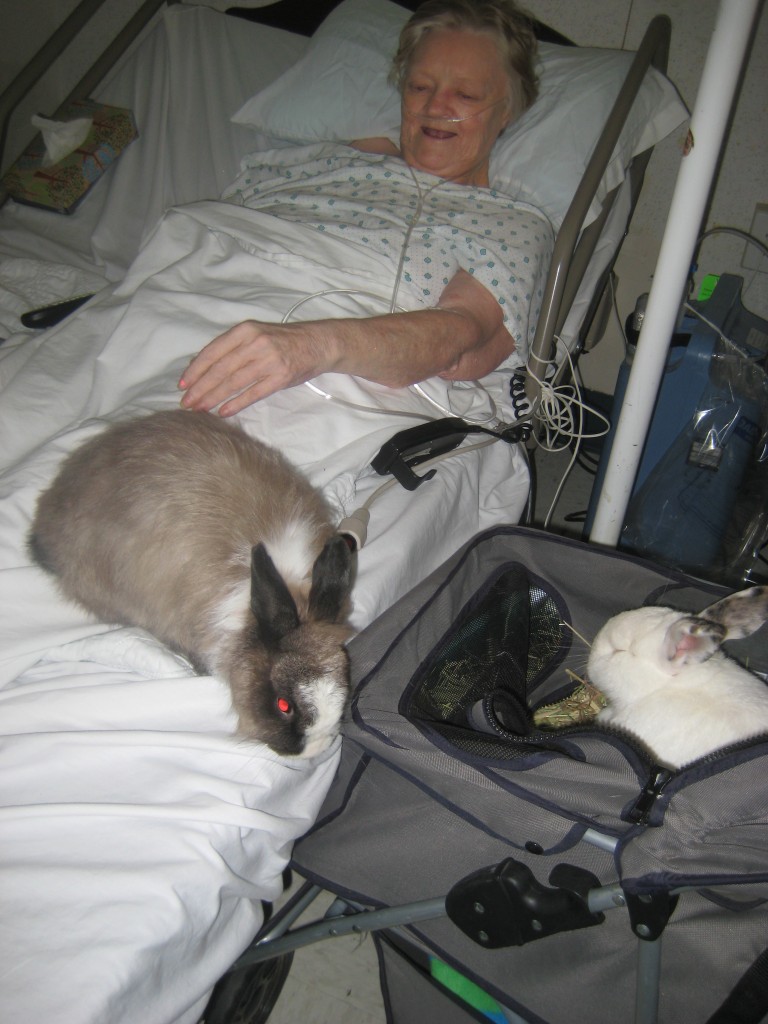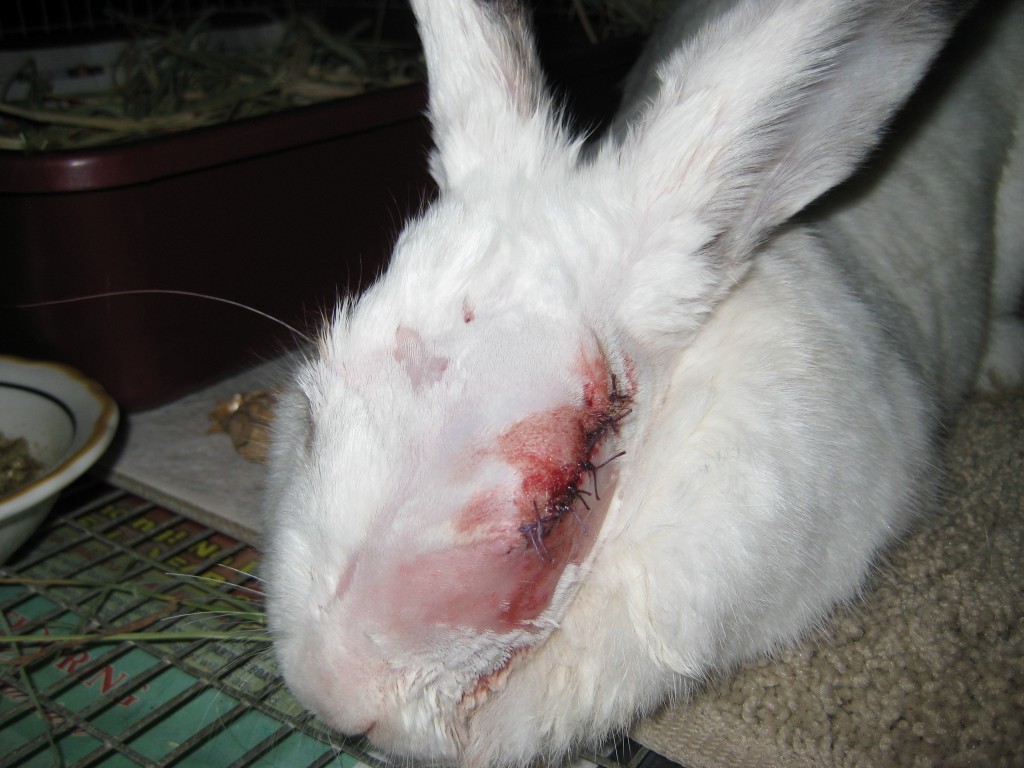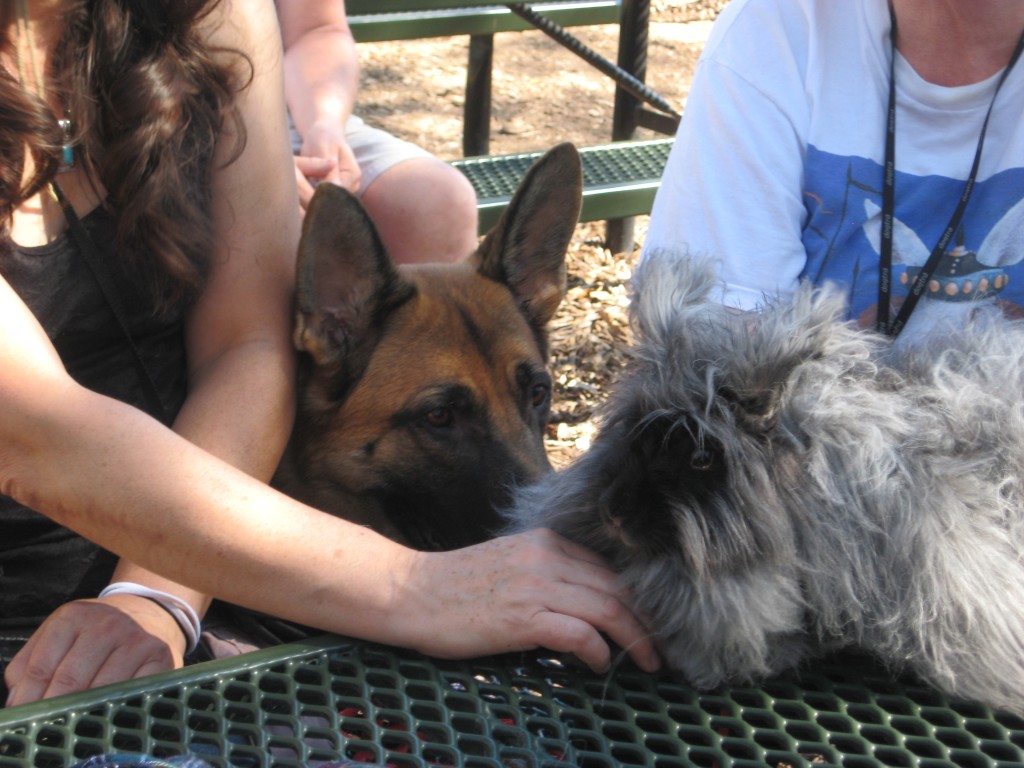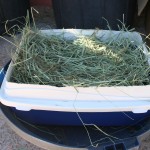
A litter box works best when filled with fresh grass hay for your bunny to graze on. It encourages good litter box habits and gives busy bunnies something to do.
I thought I would start the new year by getting into a subject that all but a true bunny lover will find strange, your rabbit’s poop. People who don’t know much about rabbits may at first feel like us bunny lovers are obsessed with this topic. This is because when you truly are aware of your bunny’s health and well-being, your first and most obvious clue that something is amiss are his fecal droppings.
Rabbits are well-designed eating and food processing machines. They have evolved to where they have extremely efficient digestive systems, otherwise how could they live with such verve and energy on a diet of just grass (which is most of a healthy rabbit’s diet). As grazers, they need to be constantly eating. It can actually be fatal if their insides stop processing their food for even a day, which is a condition known as gastrointestinal stasis or GI stasis for short.
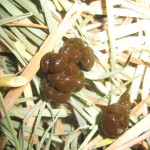
Cecotropes (cecal pellets)
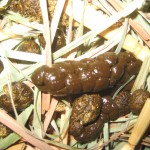
Cecotropes (Cecal pellets)
Knowing how your rabbit’s insides work are very important to keeping your pet bunny healthy. It is critical to understand that they are fermenters and that their food is digesting in their intestines by bacteria located there. This is why rabbits can often die when given the wrong antibiotic, because all the important good bacteria in their gut are killed. This is why you should never give any kind of antibiotic (or medicine) from another pet to your rabbit, without your vets express approval, but I digress.
Adding anything different or new to your rabbits fermentation system can cause an upset, until their body adapts to processing it. Us humans get a similar condition when we get Montezuma’s Revenge. Things like sugars and starches, which are not a natural part of a rabbit’s diet can cause this problem. I saw this when after not having been given fruit for many months, I gave some to my buns. They all got sick the next day. If they are getting sugars every day, then they do not get this reaction, but then that leads to other issues and problems, such as fatty liver disease and being overweight.
The best barometer of your bunny’s intestinal fortitude, so to speak, is their poop. It should be consistent and any daily variation with it is very telling. I recommend that you become very familiar with your rabbit’s little droppings daily. Every good bunny lover does this.
You want to see lots of firm but not rock hard round droppings each day in your rabbit’s litter box. They should easily smash between two fingers when fresh. It is a good idea to clean your rabbit’s box each day, because it gives you a chance to see how he is feeling by inspecting his poop. If you clean his box and there are not any in there, you now have a big red flag that should not be ignored. Rabbits are eating and pooping all the time, except for when they are sleeping. If you were to discover this, I would watch him for a couple hours to see if he goes, but if I offer him a treat or some green salad and he is not interested, it means that you have a sick bunny. Steps must be taken immediately or you possibly risk a very bad outcome. When it comes to GI stasis, time is of the essence.
If you are not cleaning your rabbit’s litter box every day, then it becomes a lot more difficult to know if he is using it or not. It is hard to tell if the piles of poop in the box are from today or yesterday or the day before, if it is not cleaned daily. Besides that, rabbits are very clean pets and tend to avoid a dirty box, not to mention that they eat more hay if you give it to them fresh in a clean box each day. Most people who have house rabbits put their rabbit’s hay into their litter box to encourage it’s use and to promote more grazing on the fresh hay.
One of the most important things you can do if you love your rabbit, is to learn to recognize when they are ill and take immediate steps to help them survive. Rabbits tend to have a very low survival rates for a lot of very common issues, simply because their owners are not paying enough attention to how their pet is feeling on a daily basis. When you think your rabbit is sick, almost 99 percent of the time HE IS.
You should familiarize yourself with what healthy good poop looks like and the difference between that and their cecotropes. Rabbits eat all of their food twice and the first time through their system, it comes out as cecotropes (or cecal pellets). They eat these and if your rabbit is healthy, you should very rarely find these, if ever. Finding cecotropes laying around or in his box are a sign that he may be getting too many treats or too much nutrition. This causes your rabbit to not feel the need to eat his cecotropes. Therefore,
finding cecal pellets from your rabbit on a regular basis should also be a red flag warning for you. I recommend taking appropriate action right away, should you begin to find these in your bunny’s area.
The most common reason for finding cecotropes is fruit, too many treats or too much green salad, or too many pellets. I would reduce the amount of these things that your rabbit receives until the problem goes away. I would start with the pellets and fruit first, since they are the highest calorie items. Rabbits do not ever need either one of those things and a very small amount goes a very long way, especially if your rabbit is of the smaller variety. A teaspoon or two is all that most bunnies need of pellets and I never give mine fruit, as I explained earlier.
It is possible to give your rabbit too much salad. He should only get an amount no more than twice the size of his head daily. That is the most he should have and he can certainly have less. Treats are also usually highly caloric and many store bought rabbit treats should never be given.
Never give your rabbit yogurt treats or anything with dairy, seeds, nuts, corn, beans, peas, legumes or popcorn. They are bad for your rabbit. Many of the rabbit treats sold in stores have one or more of these items and so beware. Just because a pet store sells them, does not mean that they are good or ok for your bunny. I would say that half of the items I see in our local pet stores should not even be sold to rabbit owners. I suggest that you give healthy green treats and compressed timothy (not alfalfa) hay cubes to your bunny. You can find some relatively healthy rabbit treats online, but avoid those that the main ingredients are flours and sugars, such as molassas or honey.
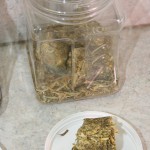
TImothy Hay Cubes are a good healthy treat for your bunny. Do not confuse them with Alfalfa Cubes, which are not the same.
One problem that you can see by looking at your rabbit’s poop is something called Mega-Colon. It is a deformation of your rabbit’s colon that causes his poop to become misshapen and egg-shaped. I have a rabbit who has this issue and her poop is sometimes small and sometimes very large, but very rarely round. This condition allows for a rabbit to easily get a condition called bloat, which is similar to colic in a horse. Bloat can be quickly fatal for a bunny. It puts intense pressure on their heart and lungs if it occurs high up in their intestines which can stop their heart or breathing. I have heard of
this happening in as little as 8 hours.
Bloat often appears to novices as GI Stasis, but can be more serious and more quickly. Your rabbit will appear to be in discomfort and will stop eating and pooping. He may keep shifting his position in an effort to relieve the gas that is building up in his abdomen. He may show signs of pain which is clicking his teeth loudly or sitting up hunched over. These are all signs that he is feeling discomfort.
To check for bloat, squeeze your rabbit behind his ribs in his belly area, gently. It should be squishy and soft, not hard and blown up like a balloon. You should do this when your rabbit is feeling fine, to acquaint yourself with how it should feel, normally. I check my Mega-Colon rabbit’s gut, every day to make sure that she is not experiencing any gas buildup, because I know that she is prone to it.
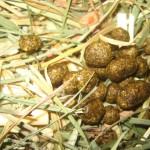
Mega-Colon poop. Notice irregular size and egg-shape.
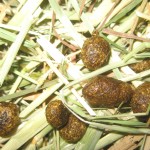
Mega-Colon poop. Egg shaped and irregular.
You should not have to normally do this, unless your rabbit is having signs that something is amiss. Lack of poop in his box or signs of discomfort are good reasons to check for bloat. Not wanting his regular daily salad or a bunny treat are also signs that it would be good to check your bunny for gas.
Because they are fermenters, they are producing gas all the time and so a blockage or GI Stasis can be the reason for their bloat. It is not something to mess with and it requires an immediate visit to the vet. Do not wait, because hours can be life or death in a severe case.
Hopefully, you will already have a relationship with a rabbit specialist vet for your rabbit. When your bunny is dreadfully sick, is not a time to be out searching for the proper vet for your bunny. It is a waste of precious time. If you need help locating a rabbit specialist, visit the House Rabbit Society website (www.rabbit.org) and go to their recommended veterinarians list for your area.
The final thing I want to mention is the “string of pearls” that we often find from our buns. This is a sure sign that your rabbit is ingesting a lot of his (or his partner’s) fur and this issue will usually go away if you groom your rabbit by combing him. Rabbits cannot throw up fur balls, like a cat can. In fact, they cannot vomit at all and so once they have swallowed fur while taking one of their many daily baths, it must pass all the way through their system.
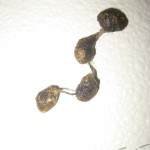
“String Of Pearls”
Generally, their system was designed for this, but they can get blockages if they swallow too much. This is especially true if they have low motility in their gut, which is slower than average movement or speed at which things move through. Low motility in a rabbit’s gut makes them more prone to fur blockage. It is best to regularly groom your rabbit and if you are finding these “string of pearls” in their litter box, then it is a sure sign that you need to “step up your grooming game”.
Every good bunny parent spends a lot of time examining and appraising their rabbit’s poop. It is part of doing it right. To the uninitiated, it may appear as if we are all a bit crazy for being into our bunny scat, but it is only because we truly love our buns and we care.
If you want to stay on top of what’s going on inside your rabbit, you too will want to learn about his poop. When you see that there is a lack of it or is has chanced in any way, you will want to find out why. Do not hesitate to call your vet and keep some of it for a sample. I have even gone as far as to email pictures of my bunny’s poop to her doctor. A rabbit’s poop tells a story, if you are savvy enough to understand what it is saying.

